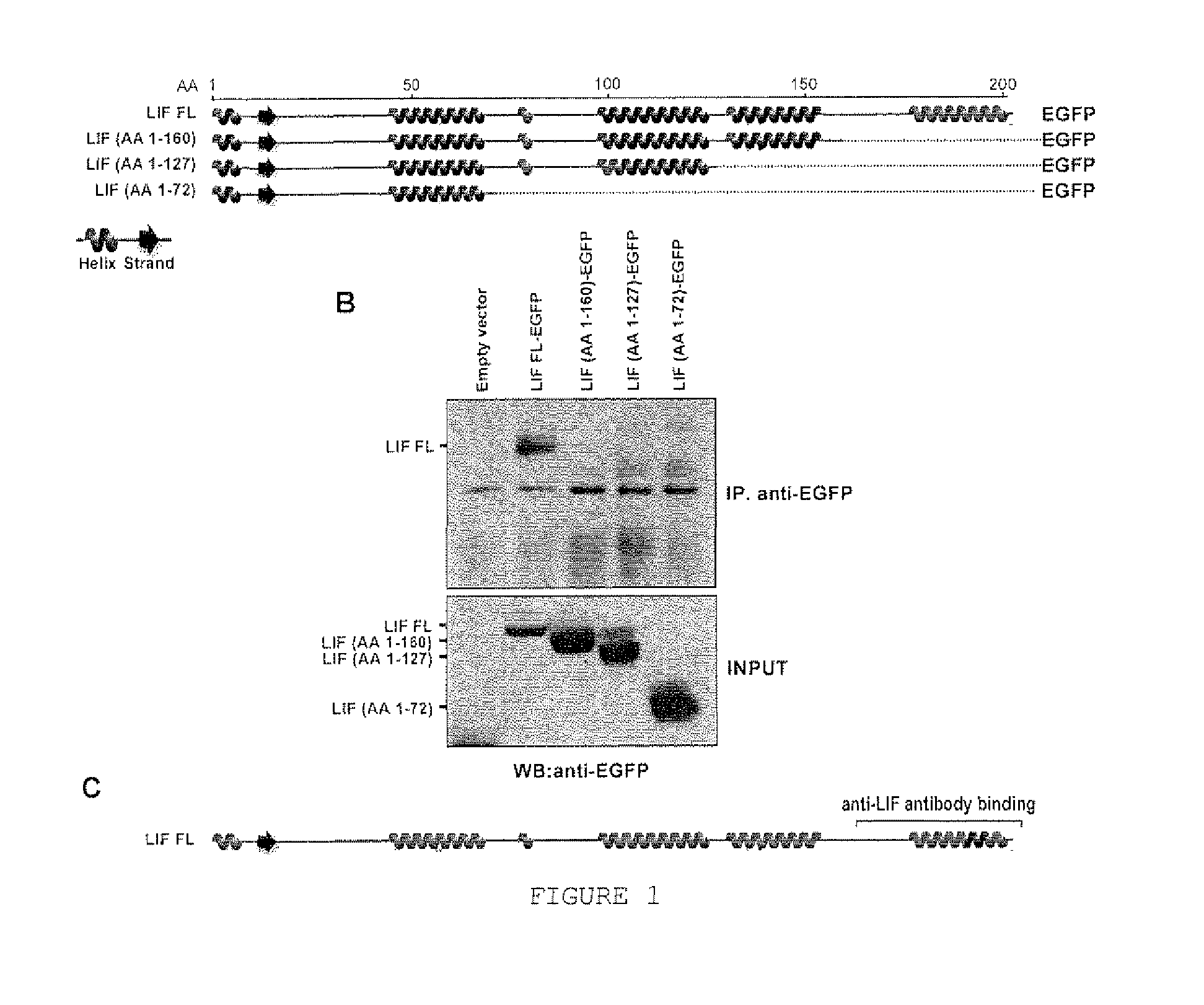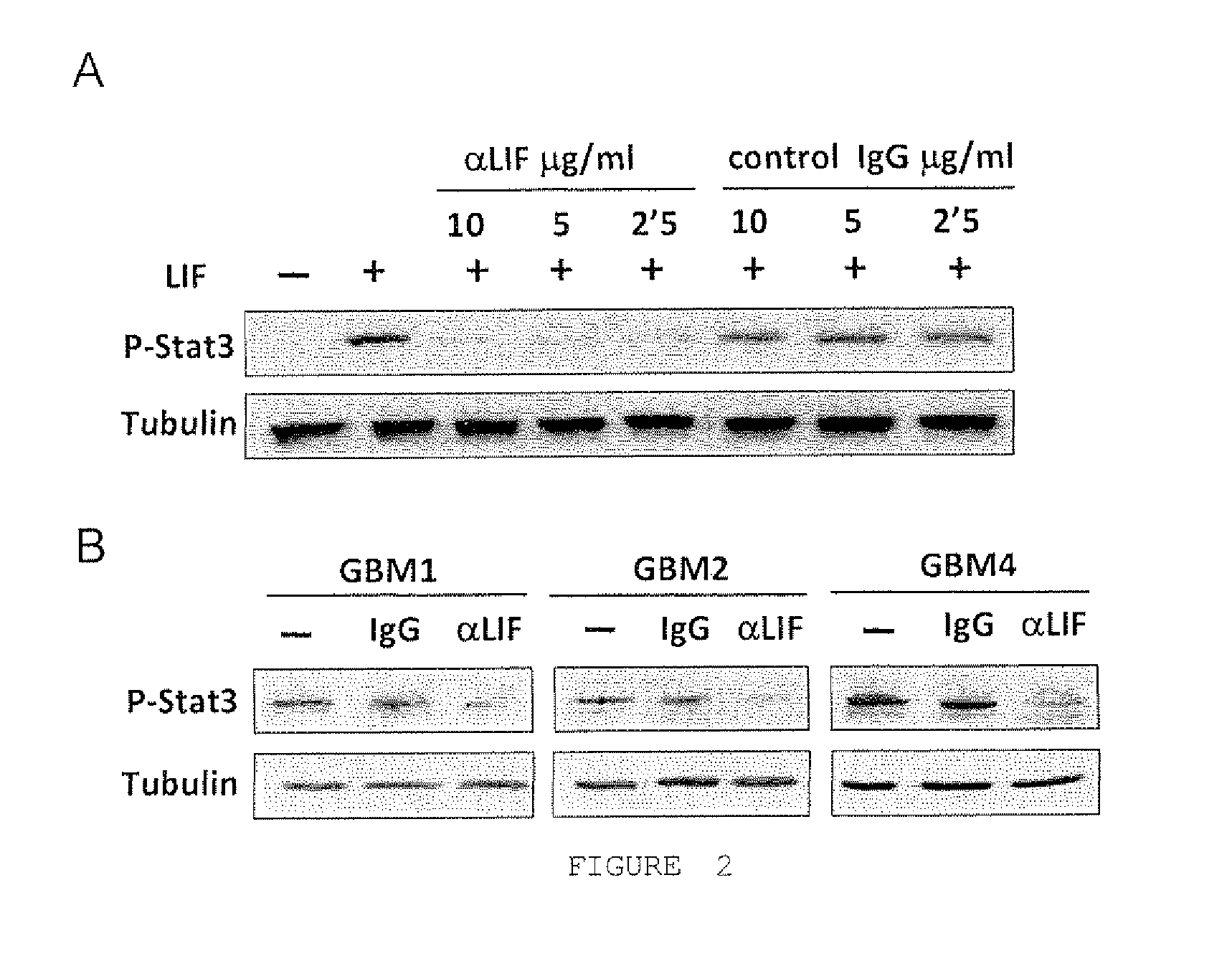Antibody recognizing human leukemia inhibitory factor (LIF) and use of Anti-lif antibodies in the treatment of diseases associated with unwanted cell proliferation
a technology of leukemia inhibitory factor and antibody, which is applied in the direction of peptides, drug compositions, and injected cells, can solve the problems of ineffective treatment of this type of tumor, inability to characterize the antigenic regions of the lif protein to which these antibodies bind, and use of these antibodies for cancer treatment, in particular glioma
- Summary
- Abstract
- Description
- Claims
- Application Information
AI Technical Summary
Benefits of technology
Problems solved by technology
Method used
Image
Examples
example 1
Hybridoma Cell Line Producing Antibodies Directed Against Human LIF
[0146]Hybridoma cell lines were generated for the purpose of production of antibodies directed against human LIF by methods well known to any person skilled in the art. From these hybridoma cell lines, one cell line was selected and deposited on Apr. 1, 2010 by Vall d'Hebron Institute of Oncology at the Deutsche Sammlung von Mikroorganismen und Zellkulturen GmbH. It was assigned the accession number DSM ACC3054. In accordance, also the homogenous population of antibodies produced by said cell line was selected. The binding specificity of anti-human LIF monoclonal antibodies (α-LIF) produced by the hybridoma cell line DSM ACC3054, deposited on Apr. 1, 2010 by Vall d'Hebron Institute of Oncology at the Deutsche Sammlung von Mikroorganismen und Zellkulturen GmbH, was subsequently determined by immunoprecipitation. To that end, 293T cells that had been transfected with C-terminally EGFP-tagged versions of the human LIF p...
example 2
The Monoclonal Anti-LIF Antibody Blocks the Induction of Phospho-Stat3 by LIF in Cell Culture and in Patient-Derived Glioblastoma Neurospheres
[0147]To test the effect of the monoclonal anti-LIF antibody produced by hybridoma cell line deposited on Apr. 1, 2010 by Vall d'Hebron Institute of Oncology at the Deutsche Sammlung von Mikroorganismen and Zellkulturen GmbH for its effectiveness in blocking effects downstream of LIF, U373 cells were treated with or without human recombinant LIF in the presence or absence of the indicated monoclonal antibody, or in the presence of an isotype-matched IgG as control. Subsequent determination of Phospho-Stat3 levels by Western Blot showed that the LIF-mediated induction of Phospho-Stat3 can effectively be blocked by administration of the monoclonal anti-LIF antibody (FIG. 2A).
[0148]To test the effect of said antibody on patient-derived cancer cells, patient derived GBM neurospheres were desegregated and optionally incubated in the presence of sai...
example 3
Patient-Derived GBM Neurospheres Contain a CD44high / Id1high Cell Compartment
[0149]CD44 is a protein described to be highly expressed in CICs of certain tumors (Visvader and Lindeman, Nat. Rev. Cancer, 8:755-768, 2008). In accordance, the authors of the present study observed that in GBM neurospheres two discrete populations expressing different levels of CD44 are present (FIG. 3A). However, the CD44high compartment has so far not been extensively studied in glioma. In order to test whether the expression of CD44 is correlated to the expression of Id1 in cells derived from patient neurospheres, the CD44high population of neurospheres from four different patients was sorted by flow cytometry upon staining of cells as described in “Material and Methods”. Subsequently, Id1 expression levels were determined in the CD44high and the CD44low populations, respectively. Interestingly, Id1 protein and RNA were detected at much higher levels in the CD44high than in the CD44low compartment (FIGS...
PUM
| Property | Measurement | Unit |
|---|---|---|
| concentration | aaaaa | aaaaa |
| length | aaaaa | aaaaa |
| secondary structure | aaaaa | aaaaa |
Abstract
Description
Claims
Application Information
 Login to View More
Login to View More - R&D
- Intellectual Property
- Life Sciences
- Materials
- Tech Scout
- Unparalleled Data Quality
- Higher Quality Content
- 60% Fewer Hallucinations
Browse by: Latest US Patents, China's latest patents, Technical Efficacy Thesaurus, Application Domain, Technology Topic, Popular Technical Reports.
© 2025 PatSnap. All rights reserved.Legal|Privacy policy|Modern Slavery Act Transparency Statement|Sitemap|About US| Contact US: help@patsnap.com



